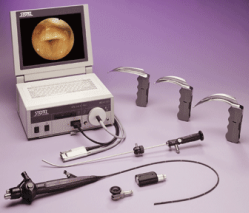
| Storz DCI Video Laryngoscope |
To reference this electronic educational resource according to the APA style for Web references, use:
Turk M, Gravenstein D (2007): Storz DCI Video Laryngoscope. Retrieved <insert date of retrieval here>, from University of Florida Department of Anesthesiology, Center for Simulation, Advanced Learning and Technology website: http://vam.anest.ufl.edu/airwaydevice/storz/index.html
Keywords: Storz, Difficult Airway Management
| Storz Videos Storz Case 1 Storz Case 2 Storz Case 3 Storz Case 4 Storz Case 5 Storz Case 6 Storz Case 7 |
 |
See videos of other airway devices in the video library
Introduction
Orotracheal intubation utilizing a Macintosh laryngoscope blade is
the most common method for securing the airway. However, direct laryngoscopy
produces a poor view in up to 7% of cases. When visualization of airway
structures is compromised, it is common (70%) for intubation to be
rendered more difficult (1). Difficulty viewing the airway with
a conventional laryngoscope blade (Miller or Macintosh) also leads
to ineffective teaching as an observer must lean over the shoulder
of the operator to catch a glimpse of important structures and relationships.
Recently, video-capable laryngoscopes that capture images from beyond the tip of the blade and display them on monitors have improved teaching and learning. An ability to demonstrate anatomy and factors making ventilation, visualization and intubation difficult as well as manipulations that improve conditions contribute to an enhanced teaching/learning experience (2).
The Storz DCI video laryngoscope system is one of the several airway devices on the market that incorporate video capability into the blades (3). The Storz DCI intergrates a fiberoptic bundle in the standard Macintosh blade. A CCD (charge coupled device) camera housed in the laryngoscope handle produces the images. The Storz DCI Video Laryngoscope has been used successfully in difficult airways (4), bariatric (5), thoracic (6) and pediatric (7) surgeries.
- Zwissler B, Hofstetter C: Department of Anesthesiology, Intensive Care and Pain Management, Johann Wolfgang Goethe University Hospital, Frankfurt am Main The DCI Video Laryngoscope
- Marshal B. Kaplan MD, Denham S. Ward MD, Berci G: A new video laryngoscope-an aid to intubation and teaching. J Clin Anesth 14:620-626, 2002.
- Kaplan MB, Ward D, Hagberg CA, Berci G, Hagiike M: Seeing is believing: the importance of video laryngoscopy in teaching and in managing the difficult airway. Surg Endosc 20:S479-S483, 2006.
- Hagberg C, Vogt-Harenkamp CC, Bogomolny Y, Ellis S, Nguyen TV: A comparison of laryngoscopy techniques using the video laryngoscope and the traditional Macintosh laryngoscope in potentially difficult to intubate patients. Anesth Analg 100:S-212, 2005.
- Hagberg C, Matuszczak M, Ellis S, Lannucci D: A randomized comparison of laryngoscopy techniques using the video laryngoscope and the traditional Macintosh laryngoscope in obese patients. Anesthesiology 103:A1421, 2005.
- Kaplan M, Ward D, Berci G: Video techniques in thoracic anesthesia. Surg Anesthesia 21:204-210, 2002.
- Weiss M, Hartmann K, Fischer J, Gerber AC: Video-intuboscopic assistance is a useful aid to tracheal intubation in pediatric patients. Can J Anaesth 48:691-696, 2001.